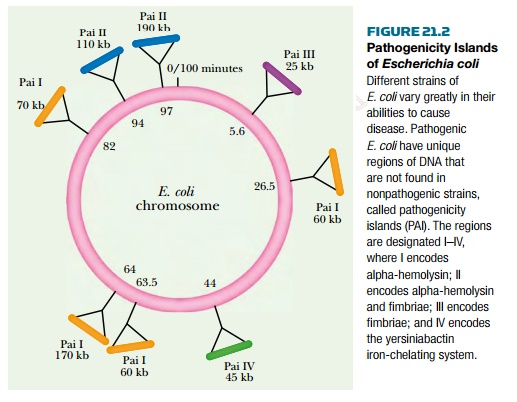Chapter: Biotechnology Applying the Genetic Revolution: Bacterial Infections
Virulence Genes Are Often Found on Mobile Segments of DNA
VIRULENCE
GENES ARE OFTEN FOUND ON MOBILE SEGMENTS OF DNA
Many infectious diseases are caused by
bacterial invasion of the human body. Some pathogenic bacteria penetrate the
interior of host cells, whereas others remain outside and inhabit extracellular
spaces. The molecular mechanisms involved in infectious disease vary greatly in
detail. Nonetheless, invading microorganisms face similar problems and so share
many of the same general abilities. Properties that allow microorganisms to
cause infections are called virulence factors and may be subdivided into three
main groups: those required for invasion of the host, those for survival inside
the host, and those for aggression against the host.

The blocks of DNA encoding virulence
factors are often mobile. In some cases (e.g., anthrax, bubonic plague) they
are borne on virulence plasmids . In other cases (e.g., cholera toxin, diphtheria
toxin), they may be carried on lysogenic bacteriophage and inserted into the chromosomes
of certain bacterial strains. In yet other cases, they are grouped together in
regions of the chromosome flanked by inverted repeats and known as
pathogenicity islands ( Fig. 21.2 ). The inverted repeats imply that the pathogenicity
islands may move as a unit by transposition.The same or closely related
virulence factors may be chromosomally integrated in one bacterial strain and plasmid-borne
in others.
The mobility of virulence factors has
several implications. First, closely related bacterial strains vary enormously
in their capacity to cause disease. Harmless bacterial strains that are closely
related to cholera, plague, diphtheria, anthrax, and so on are widely
distributed, but normally draw little attention. Second, virulence factors may
be transferred to hitherto harmless strains, thus creating novel pathogens in
one or a few steps. If the harmless strain is a close relative, we may merely
get a new variant of an old disease (e.g., the new biotypes of cholera that
have appeared over the past century are due to transfer of the CTXphi phage
into harmless strains of Vibrio ). However, if the recipient for a block
of virulence factors is unrelated to the previous “owner,” a genuinely novel
bacterial pathogen may be created. It seems likely that bubonic plague, Yersinia
pestis , arose in this way several thousand years ago. Apparently an
ancestral Yersinia that caused a mild intestinal infection was
transformed by acquiring two virulence plasmids into a devastating disease injected
directly into the bloodstream by fleas.
Related Topics